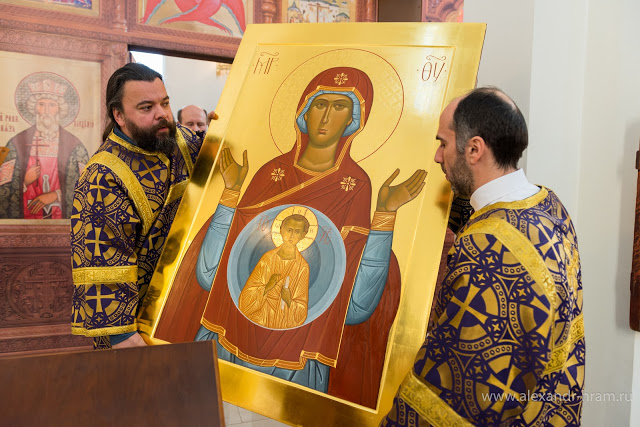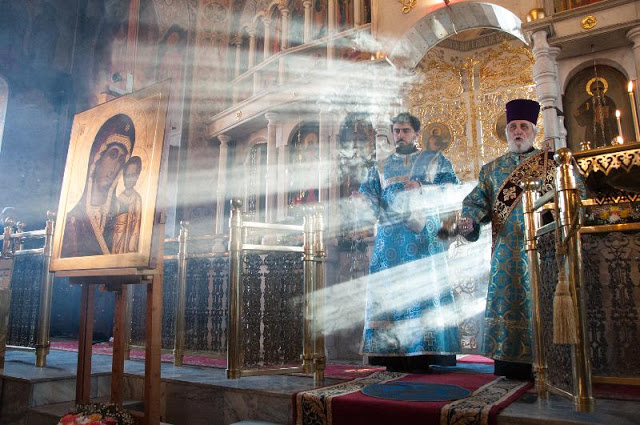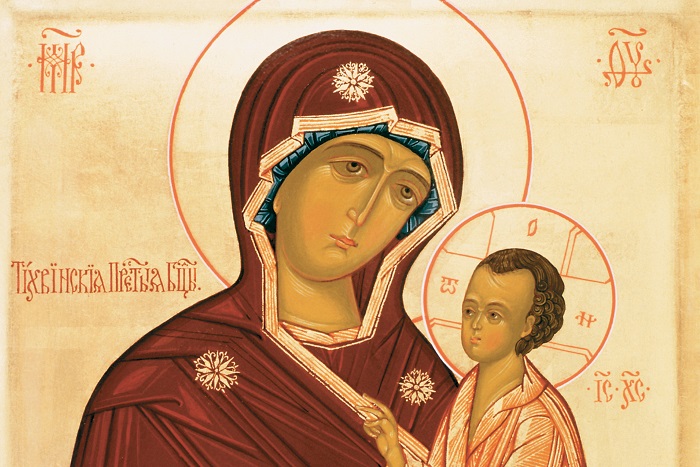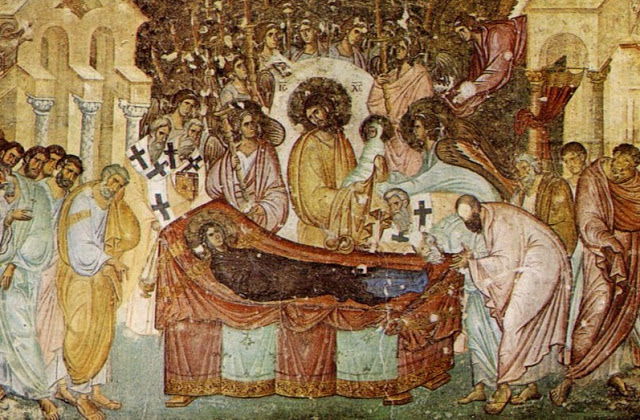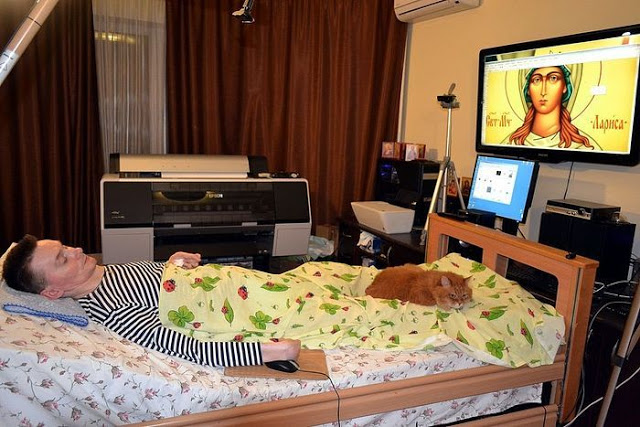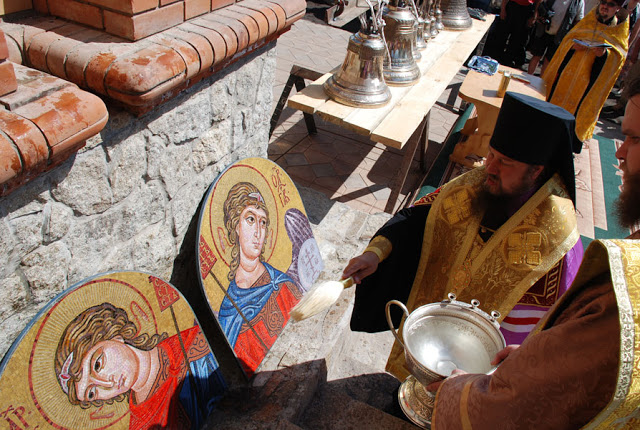
The Question
Orthodox Christians routinely have their icons blessed by a priest or bishop. Bishops often anoint them with Holy Chrism. There are even special services for blessing different kinds of icons: of Christ, of the Mother of God, of feasts, etc. Most people would never imagine putting an unblessed icon in their houses; it would be a kind of sacrilege, but once the icon is blessed — whatever its subject, taste, canonicity, etc. — many think that what was a simple picture before the blessing becomes an icon after, because of the blessing. It becomes at least a “better” icon. Being only a “profane” image before, it becomes “holy” after, because it has been blessed. Very few Orthodox would question this practice which they feel is legitimate, traditional, and totally in agreement with Church Tradition. I hope to show that despite the widespread habit of blessing icons, this practice is not in agreement with Church Tradition, and that it is in fact contrary to it and based on a theology of the icons that is foreign to Orthodoxy.
The History
From Pentecost, 33, to the 7th Ecumenical Council, 787, which condemned iconoclasm:
During this period, there is a total silence in the historical documents. As far as we know, no one ever wrote on the subject of blessing images, and there is no trace of a prayer for blessing them.
The Time of Iconoclasm, 730-843:
The Second Council of Nicaea, 787. Here is one of the attacks made by the iconoclasts against the iconodoules, read during the council along with the answer given by the Fathers.
The Iconoclasts: …nor is there any prayer of consecration for it [an icon] to transpose it from the state of being common to the state of being sacred. Instead, it remains common and worthless, as the painter made it. The Orthodox: …many of the sacred things which we have at our disposal do not need a prayer of sanctification, since their name itself says that they are all-sacred and full of grace. Consequently, we honor and embrace them as venerable things. Thus, even without a prayer of sanctification, we revere the form of the life-giving cross. The very form of it is sufficient for us to receive sanctification. By the veneration which we offer to it, by the making of its sign on our forehead, and also by the making of its sign in the air with the finger, like a seal, we express the hope that it dispels demons. In the same way, when we signify an icon with a name, we transfer the honor to the prototype; by embracing it and offering to it the veneration of honor, we share in the sanctification. Also we kiss and embrace the different holy utensils which we have, and we express the hope of receiving a blessing from them. Therefore, either they [the iconoclasts] must say idly that the cross and the holy utensils are common and worthless — since it is a carpenter, or a painter, or a weaver who has made them, and because there is no prayer of consecration for them — or they will have to accept also the venerable icons as sacred, holy, and worthy of honor.
For, just as when one paints a man, one does not render him without a soul, but he remains one who has a soul and the icons is called his because of his resemblance, so it is when we make an icon of the Lord. We confess the Lord’s flesh to be deified, and we know the icons to be nothing else but icons, signifying the imitation of the prototype. It is from this that the icon has taken also the name of the prototype, which is the only thing that it has in common with the prototype. That is why it is venerable and holy.
The Life of Steven the Younger:
Chapter 5: “Recall from Exile. Conversation with Constantine V”
The saint [Steven] answered him [Constantine V]: “Oh Emperor, it is not the matter that is in icons that Christians have ever been ordered to worship, but they prostrate themselves in front of the name of the person who is seen on the icon…”
Then the saint replied: “And who then in his right mind worships what is created when he prostrates himself in front of objects that are in the churches, whether they be of wood, stone, gold, or silver, and that have been changed into holy objects by the name written on them?”
Nicephorus of Constantinople, Discourses against the Iconoclasts:
“In truth, just as churches receive the name of their holy patron saints, so also images of those saints have their names written on them, for it is what is written on them [the name] that makes them holy.”
In this treatise, the Patriarch attacks the affirmations and arguments of the Emperor Constantine V who convoked the Council of Hieria in 754 to give approval to his iconoclastic doctrine. The emperor maintained that an image of someone, in order to be properly called image must be consubstantial with the prototype. So then the only image of Christ which is consubstantial with him, of the same substance as him, is the Eucharist, the holy gifts of communion. All other “images” of Christ and the saints are falsely called images because their substance — wood, stone, colors, etc. — are different from that of the persons represented. What is more, for the bread and wine to become the consubstantial image of Christ, there must be a prayer of consecration in the liturgy to change them. The “images” of Christ and the saints are falsely called images for two reasons: [their substances are different, and] there is no prayer of blessing to transform them into the substance of Christ and the saints.
In answering the emperor, Patriarch Nicephorus attacked his position saying that the emperor was trapped in a double error. First, to the argument that the image and its prototype must be consubstantial, Nicephorus answers that the link between the image — the type — and the person represented — the prototype — is not one of consubstantiality, but likeness and the sharing of the person’s name. The image of Christ, he continues, being made of wood and colors, is called Christ because it resembles him in that it reproduces the physical characteristics of his humanity and because it carries his name. Further, Constantine was again in error because he did not distinguish two types of sanctification: the sacralization which is produced by the prayers of the Church — the blessing of water at Theophany, for example — and the sanctification that comes about by imitating Christ, by participation in his acts, words, and death — the martyr and others, for example. In the first case, a prayer of blessing is necessary; in the second, no.
English even has two words, actually the same word but pronounced differently, to distinguish these two kinds of holiness: blessed, two syllables, and blessed (blest), one syllable. “Their wedding was a blessed event which was blessed by the bishop and five healthy children.” The icon does not belong in the second category but in the first. Therefore, it is holy, not because of a blessing prayer, that the Patriarch and the Orthodox in general knew did not exist, but because of its likeness to the prototype and the fact of having his or her name written on it.
From the 9th century to the middle of the 17th century:
During these centuries, there reigns another silence in the prayer books and the writings of Orthodox authors on the subject of the blessing of icons.
1649, Metropolitan Peter Moghila of Kiev:
This is the publication date for the metropolitan’s Trebnik — Euchologion — in which, for the first time in an Orthodox source, we have short prayer services for the blessing of icons. See below, the texts and analysis of these prayers.
1669-1706, Patriarch Dositheos of Jerusalem.:
L.H. Grondijs quotes a passage of Dositheos: “Only in the 17th century did anyone start to ask questions about the subject [of blessing icons], and Dositheos of Jerusalem discussed it in a long, accusatory text against the schismatics, that is, the Roman Catholics. In the 4th chapter of his History of the Patriarchs of Jerusalem, Dositheos attributes to his adversaries (to Catholics), who favored venerating icons, the argument that the pope recites such prayers over them. Here is what Dositheos had to say: “We answer this third argument by saying that blessing icons is neither necessary or indispensable. We refer readers to the 6th session of the present council (the 7th Ecumenical Council of Nicaea) where it dealt with the council held under Copronym [Constantine V, the Council of Hieria in 754] which criticized icons in this way: [Nicaea II quoting the iconoclasts] ‘The icon does not have a blessing to be sanctified and transferred from the common to the sacred; it remains common and profane as the painter created it.’ What is more, the council answered by the voice of Deacon Epiphanius but did not say that there was a blessing for icons, but that the image of the cross was not blessed and that it was made without a blessing.
1730, The First Blessing Prayer for an Icon in a Greek Euchologion:
When a Bishop blesses the Ikon, he anoints the four sides of it with Holy Chrism, and then says the following prayer:
Bishop: Let us pray to the Lord.
Response: Lord, have mercy.
Bishop: Master, our Almighty King, Father of our Lord and Savior Jesus Christ, You gave orders to your servant Moses to sketch a picture of a Cherub in the holy Tent, and from this, we took the custom of sketching icons as a remembrance of those whom they represent. Therefore, we pray to You, O Lord our King, to send the grace of your Holy Spirit, together with your angel, on this holy icon so that every prayer which is offered to You through this icon may be accepted by the grace, mercy, and compassion of your only-begotten Son, our Lord, God and Savior, Jesus Christ, the Lover of Mankind.
For all glory, honor, and worship are yours due, Father, Son and Holy Spirit, now and always and for ever and ever. Amen.
Thefollowing passage is a note included in the Euchologion by its publisher.
About the prayer that the bishop says over the newly painted icon, please note that the Sacramentaria Latina contains a similar blessing without anointing with chrism, especially what is used in the Ordo Praedicatorum, as well as the Pontificale Romanum. Even though in the past, due to too much negligence, a blessing of this manner was rejected by usage, but now this fundamental books that [that we have] in hand conserves and maintains them.
Analysis of the Blessing Prayers
The Slavonic Texts
Let us examine first of all the prayers introduced by Metropolitan Peter Moghila into his Euchologion/Trebnik in 1646. There are five short services for blessing icons:
- The Holy Trinity: the three angels (Hospitality of Abraham), Theophany, the Transfiguration, and the Descent of the Holy Spirit;
- Christ and the feasts of the Savior;
- The Mother of God;
- The Saints;
- Various icons laid out together.
First of all, note the number of categories, five; why multiply the number of separate services, especially when the last blessing service combines all the categories. Obviously the Metropolitan thought it was a good thing to have five blessing services. Even though he had leanings toward things Latin, Roman Catholicism was the great adversary of Orthodoxy at the time, and I wonder if he did not want to impress the Catholics, as well as the Orthodox, by the number of prayers. Actually feeling inferior to the Latin Catholics, he probably wanted blow the Orthodox horn to show Orthodoxy’s superiority: “You see, you Catholics, who think you’re so superior, we Orthodox have five services for the blessing of icons.” This is, however, only my hypothesis.
The structure of each service is the same. The differences between them are found in the references to the Bible and Church history, references that change with the various categories of icons: for example, singing the troparion of Theophany for an icon of the Baptism of Christ, mentioning the story of King Abgar for an icon of Christ, etc. Here is the structure of the services:
- An initial blessing: “Blessed is our God…”, initial prayers and a psalm that appropriate for the icon category;
- A great blessing prayer (almost an anaphora),
- Commemoration of the the event in the Bible or Church history that is the basis of the icon,
- The first epiclesis which asks the Lord tobless the icon,
- An ecphonesis;
- A second epiclesis for blessing;
- Sprinkling with holy water;
- The troparion or hymn of the icon or the feast;
- The dismissal.
Let us now look closer at the significant parts of the blessing: We do have here a real invocation, epiclesis, of the Lord to act and bless the images. It is noteworthy that the epiclesis is faithful to the Orthodox tradition which sees any blessing as an invocation asking that the grace of God, the Holy Spirit, come down not only on a particular object but also and, first of all, on “us,” the faithful who are going to prayer in front of the image. The most obvious example of such an epiclesis is the one in the Eucharistic liturgy.
In the first epiclesis, we hear petitions like the following:
…and we pray and entreat and humbly beseech Thy deep compassion: Do Thou look down mercifully upon us and send down Thy heavenly blessing, and in Thy Thrice-holy Name, bless and sanctify it (them)… Do Thou look down with mercy upon us and upon this Icon (these Icons)…send down upon it (them) Thy heavenly blessing and the grace of the Most-holy Spirit and
bless and sanctify it (them)…
bless and sanctify it (them)…
The second epiclesis:
…do Thou harken now unto our prayer and send down Thy divine heavenly blessing and bless and sanctify this Icon (these Icons) by the sprinkling of this Holy Water… Through her [the Mother of God] prayers and intercessions, by Thy grace in the sprinkling of this Holy Water, bless and sanctify this Icon…
The sprinkling with holy water:
This Icon is sanctified by the grace of the Most-holy Spirit, through the sprinkling of this Holy Water, in the name of the Father, and of the Son, and of the Holy Spirit.
The Greek Prayer:
The first thing we notice is that the Greek prayer is much shorter; just one short prayer. Here is its structure:
- Instruction to the bishop (pontifex/archiereus) to anoint the icon on its four corners;
- A very short reference to and commemoration of Moses and the cherubim;
- Epiclesis for the grace of the Holy Spirit, as well as an angel, to descend on the icon “so that every prayer which is offered to You through this icon may be accepted…”;
- Ecphonesis.
It is very important to underscore the note added, I presume, by the Greek Orthodox editor of the Euchologion. (See the text above.) He admits that the practice of blessing icons is an innovation, but he attributes the lack of blessing prayers to “too much negligence” in the past. The editor appears happy to have “rectified” this problem by adding the prayer. He obviously gets part of his inspiration from three Catholic texts, and feels — I are reading between the lines — relieved now that the Greek Orthodox do like the Roman Catholics. Not only has he taken his queue from a Catholic model, but he also judges the Orthodox tradition of not blessing icons to be a “negligence.” What the Greek prayer lacks in length and development in relation to the Slavonic texts, it, and the note, make up for by their clarity about the reason the prayer was introduced into a Greek euchologion. I suspect, however, without direct confirmation, that Metropolitan Peter Moghila had the same reason. The Roman Big Brother blesses paintings while the poor Orthodox do not. An obvious sign that the Orthodox must abandon their own tradition and adopt a new practice, and the theology that justifies it, both of which come from a source other than that of the councils and fathers of the Church.
Conclusion
So, if my analysis is correct, we must simply recognize a very bizarre phenomenon: a practice and a theology that justifies it, both of which are widely accepted among Orthodox Christians and are “officialized” by services in the euchologions/trebniks, are in fact contrary to the Tradition of the Orthodox Church as that was expressed by the 7th Ecumenical Council as well as by the universal practice of the Church until 1649. Even though some have protested against this situation, their protests have not been enough to realign the practice and thinking of Orthodox faithful and clergy about blessing icons. Is this situation surprising? Tragic yes, but surprising? No.
I answer “no” when I take into account the fact that the introduction of the icon blessing prayers coincides with the decadence of icon painting. From the 17th century, images among the Orthodox started to depart from the canonical tradition. So why should we be surprised if the theology of some and the prayers many did the same? From the point of view of the art historian, this situation is but one more phenomenon to recognize and to study, nothing more. But, for Orthodox Christians, the Church’s iconography should never be studied outside the Tradition that gave it life, as do art historians. We Orthodox must deal with the subject from within the Tradition, as an expression of our faith, of the faith of our Church — and even better, as an expression of the Church’s faith, period. Art historians — even Soviet ones — have made remarkable studies of icons, and we are enormously indebted to them for their works. The more we can learn the better, whatever the source, but for art history, as for religious studies as opposed to theology, researchers study their subject as something detached from themselves; they examine it “scientifically,” “objectively,” “coldly.” Art history can never study icons as a theological phenomenon, that is, as a manifestation, a revelation of Christ in his Church. But then, this is precisely our point of view. Therefore, it can only be catastrophic when the iconographic tradition of the Orthodox Church departs from its own sources; it can only be a pollution of that tradition and of the revelation itself. But as we have seen, there have been voices crying in the wilderness.
If it is true that we are living in the full bloom of a renaissance of traditional and canonical icons, despite the opposition of certain Orthodox themselves, we cannot limit ourselves to just the visible aspect of the tradition, that is, to icons themselves, but we must examine all the elements that surround the iconographic tradition. That is why I want to draw attention to a phenomenon which, from my point of view, is not in agreement with the Church’s purest tradition; I seek to invite the faithful and clergy to greater vigilance. If all Orthodox agree that it is always necessary to defend Holy Tradition against corrupting influences, then we must make sure that what we defend is in fact part of that Tradition.
As for a dedication ceremony to put a stamp of approval on an icon and to begin its official veneration and public reception, why do we not ask a liturgist to prepare a service of dedication that will set out the theology of the icon as found in the long prayers of the Slavonic services. This public dedication service could include a procession of the icon after which it would be placed on an analoy in the middle of the church. Then, perhaps a litany for all those connected with the painting of the icons, with an invocation of the Holy Spirit on all who will venerate it. After that, the clergy and the faithful would venerate it publicly for the first time. Finally, the priest would bless the faithful with the icon, as he does with the Gospel book. Such a ceremony would have the advantage of showing the Church’s approval and reception of a new icon while avoiding the notion set out by the present services: by priestly prayers and ministrations, an unsanctified painting becomes a holy icon.

